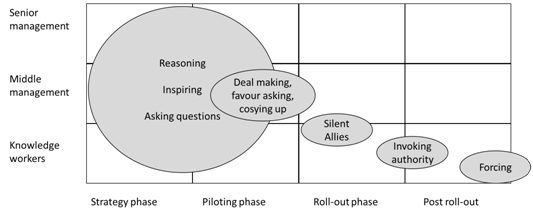An influencing strategy for introducing KM
Introducing Knowledge Management into an organisation is largely a process of influencing, advocating and selling. Here is some guidance on which influencing tools to use as your program progresses.
I wrote a blog post just before lockdown, listing 9 influencing tactics you can use when introducing Knowledge Management. The 9 tactics come from The Farnham Street blog (reporting on the book Mind Gym) and are as follows:
- Reasoning – the process of using facts, logic, and argument to make a case.
- Inspiring – focusing on the heart rather than the head, appealing to emotions and creating the vision.
- Asking Questions – leading the other person to make their own discovery of the value of Knowledge Management.
- Cosying Up You almost always feel positive toward someone who makes you feel good about yourself.
- Deal Making – when you give another person something in return for their agreement with you. “
- Favour Asking – simply asking for something because you want or need it.
- Using Silent Allies (aka social proof)
- Invoking Authority – appealing to a rule or principle.
- Forcing “Do it or else.”
The picture above shows when, and at what level, to use the different tactics, depending on the phase of implementation.
- Reasoning, Inspiring and Question-asking are useful at any stage, but are your prime strategies in the early stages of implementation, and when working with senior management. By using these techniques, you help make the business case and sell the vision of KM.
- Deal making, favour asking and cosying up come into their own when trying to influence middle managers to host a KM pilot.
- The use of social proof and silent allies is particularly important during the roll-out phase. You can use success stories from the piloting phase to influence others to try, and adopt, KM.
- Invoking authority and forcing can only be used late on, during or after roll-out, once KM has become a clear corporate expectation. However once the expectation is clear, then these tactics are very powerful.


Leave a Reply